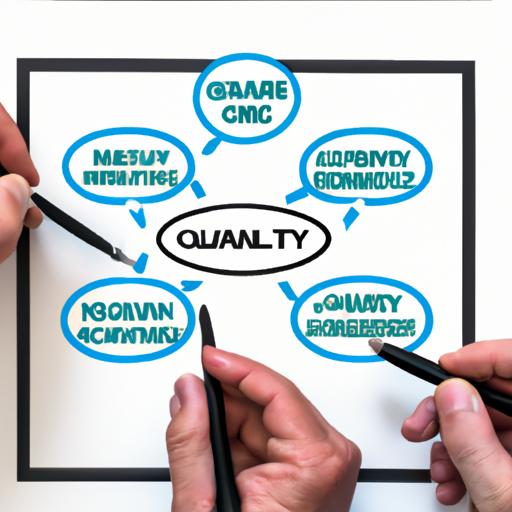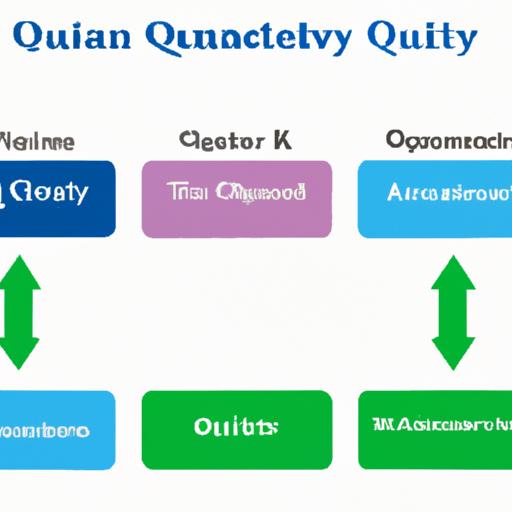Introduction
In today’s data-driven world, organizations are constantly grappling with an overwhelming amount of data. However, the true value lies not just in the quantity but the quality of the data. This is where a robust data quality management framework comes into play. By implementing an effective framework, businesses can ensure the accuracy, completeness, consistency, and reliability of their data, unleashing its full potential.
Defining Data Quality Management Framework
A data quality management framework encompasses a set of processes, policies, and tools designed to maintain and enhance the quality of data throughout its lifecycle. It involves a systematic approach to identify, measure, improve, and monitor data quality, ensuring that the data meets the specific requirements and objectives of the organization. Without a well-defined framework, businesses risk making critical decisions based on inaccurate or incomplete data, leading to costly consequences.
Importance of Data Quality Management Framework
Imagine building a house on a shaky foundation – it would be destined for failure. Similarly, relying on poor-quality data can jeopardize the success of any business endeavor. A data quality management framework establishes a solid foundation for data-driven decision-making, operational efficiency, and regulatory compliance. It enables organizations to trust their data, gain valuable insights, and make informed decisions that drive growth and innovation.
By implementing a data quality management framework, businesses can:
- Minimize the risks associated with poor data quality
- Improve operational efficiency and productivity
- Enhance customer satisfaction and loyalty
- Ensure compliance with industry regulations and data protection laws
- Optimize resource allocation and cost management
In the next section, we will delve deeper into the essential components of a data quality management framework, uncovering the key pillars that support the integrity and reliability of data. So, let’s explore how data governance, data quality assessment, data quality improvement, data quality monitoring, data quality measurement, and data quality reporting form the backbone of an effective framework.
Components of a Data Quality Management Framework

A. Data Governance
Data governance serves as the foundation of a data quality management framework. It involves establishing a set of policies, procedures, and guidelines to ensure the effective management and control of data assets within an organization. With clear roles, responsibilities, and accountability, data governance ensures that data is accurate, consistent, and reliable. It focuses on defining data standards, data ownership, data access controls, and data lifecycle management.
B. Data Quality Assessment
Data quality assessment is a crucial step in identifying and understanding the current state of data quality within an organization. It involves evaluating the accuracy, completeness, consistency, timeliness, and relevancy of data across various dimensions. Through data profiling, data cleansing, and data validation techniques, businesses can identify data anomalies, errors, and inconsistencies. This assessment forms the basis for developing data quality improvement strategies.
C. Data Quality Improvement
Once data quality issues are identified through assessment, the next step is to implement data quality improvement measures. This involves defining and implementing data cleansing, data enrichment, and data validation processes. By addressing data quality issues at their root, organizations can ensure that data is accurate, complete, and consistent. This step may involve collaboration between IT teams, data stewards, and data owners to implement data quality improvement initiatives effectively.
D. Data Quality Monitoring
Data quality monitoring is an ongoing process that involves continuous assessment and tracking of data quality metrics. By establishing data quality rules, organizations can monitor data for adherence to defined quality standards. This ensures early detection of data quality issues and enables proactive measures to maintain data integrity. Automated data quality monitoring tools and dashboards aid in real-time monitoring and alerting when data quality thresholds are breached.
E. Data Quality Measurement
Measuring data quality is essential to quantify the effectiveness of data quality improvement initiatives. This involves defining relevant metrics and key performance indicators (KPIs) to assess the success of data quality management efforts. Metrics such as data accuracy, completeness, consistency, and timeliness provide insights into the overall data quality levels. Regular data quality measurement helps organizations track progress, identify trends, and make data-driven decisions.
F. Data Quality Reporting
Data quality reporting plays a crucial role in communicating data quality insights and outcomes to stakeholders. It involves creating comprehensive reports and visualizations that highlight data quality metrics, trends, and improvement initiatives. Data quality reports facilitate transparency, accountability, and decision-making across the organization. By providing clear visibility into data quality performance, businesses can drive continuous improvement and demonstrate compliance with data quality standards.
In the following section, we will explore the myriad benefits that organizations can reap by implementing a robust data quality management framework. So, let’s dive into the advantages of harnessing the power of quality data.
Benefits of Implementing a Data Quality Management Framework

In today’s fast-paced business landscape, organizations that prioritize data quality management frameworks reap numerous benefits. Let’s explore some of the key advantages that come with implementing such frameworks.
Improved Decision-making
Data is the lifeblood of decision-making processes. By ensuring data quality through a robust management framework, organizations can make more accurate and reliable decisions. High-quality data provides a solid foundation for strategic planning, forecasting, and identifying trends. With trustworthy data at their fingertips, decision-makers can have confidence in their choices, leading to better outcomes and a competitive edge in the market.
Enhanced Operational Efficiency
Data quality issues can impede various operational processes, leading to inefficiencies and increased costs. By implementing a data quality management framework, organizations can streamline their operations. Clean and reliable data enables smoother data integration, data migration, and data sharing across different systems and departments. This, in turn, improves process efficiency, reduces errors, and eliminates time-consuming data inconsistencies, leading to significant cost savings and improved productivity.
Increased Customer Satisfaction
Customers are at the heart of every successful business. Ensuring data quality helps organizations better understand their customers, personalize their experiences, and deliver relevant products and services. By having accurate and complete customer data, businesses can develop targeted marketing campaigns, provide personalized recommendations, and resolve customer issues more effectively. This leads to increased customer satisfaction, loyalty, and ultimately, a stronger bottom line.
Compliance with Regulatory Requirements
In today’s data-centric world, organizations must comply with various regulations and data protection laws. Implementing a data quality management framework helps businesses maintain compliance with these requirements. By ensuring data accuracy, privacy, and security, organizations can mitigate the risks of data breaches, penalties, and reputational damage. A robust framework provides the necessary controls and protocols to meet regulatory obligations, protecting both the organization and its customers.
Next, we will explore the essential steps to implement a data quality management framework successfully. Join me in the next section as we dive into the practical aspects of establishing a strong foundation for data quality management.
Steps to Implement a Data Quality Management Framework

A. Define Data Quality Goals
To kickstart the implementation of a data quality management framework, it is crucial to establish clear and measurable data quality goals. Begin by identifying the specific areas where data quality is paramount for your organization. Are you aiming to improve customer data accuracy or enhance the consistency of financial records? By defining these goals, you set a clear direction for your data quality efforts.
B. Establish Data Governance Structure
Data governance plays a pivotal role in ensuring data quality across the organization. It involves the creation of a framework that defines roles, responsibilities, and processes for managing and maintaining data integrity. Establish a dedicated data governance team, comprising representatives from various departments, to oversee the implementation of data quality policies, standards, and procedures. This team will act as the driving force behind data quality initiatives, ensuring accountability and compliance throughout the organization.
C. Assess Data Quality
Before making any improvements, it is essential to assess the current state of data quality within your organization. Conduct a comprehensive data quality assessment to identify any existing issues or discrepancies in your data. This assessment can involve data profiling, data cleansing, and data validation techniques to uncover inconsistencies, duplications, and inaccuracies. The insights gained from this assessment will serve as the foundation for developing targeted data quality improvement strategies.
D. Develop Data Quality Improvement Strategies
Based on the findings from the data quality assessment, develop tailored strategies to address the identified data quality issues. This may involve implementing data cleansing techniques, establishing data validation rules, or enhancing data integration processes. Collaborate with relevant stakeholders, such as data owners, IT teams, and business users, to create a roadmap for data quality improvement. Remember, each strategy should align with the defined data quality goals and contribute to the overall framework.
E. Monitor and Measure Data Quality
Implementing a data quality management framework is an ongoing process that requires continuous monitoring and measurement. Establish mechanisms to regularly monitor the quality of your data, leveraging automated tools and data quality metrics. This will help you identify any emerging issues and ensure the sustainability of your data quality initiatives. Regularly measure key data quality metrics, such as accuracy, completeness, timeliness, and consistency, to track progress and identify areas for further improvement.
F. Report and Communicate Data Quality Results
Effective communication and reporting are vital to ensure transparency and accountability in data quality management. Develop a reporting mechanism to provide stakeholders with regular updates on data quality performance and progress. This can include executive dashboards, data quality scorecards, and comprehensive reports. By sharing the results of your data quality efforts, you can foster a culture of data-driven decision-making and reinforce the importance of data quality throughout the organization.
In the next section, we will explore best practices for successfully implementing a data quality management framework. These practices will guide you in overcoming common challenges and ensuring the long-term success of your data quality initiatives. So, let’s delve into the key strategies for achieving excellence in data quality management.
Conclusion
In today’s data-driven world, a data quality management framework is not just a luxury but a necessity for organizations to thrive. As we have explored, this framework plays a crucial role in ensuring the accuracy, completeness, consistency, and reliability of data, enabling businesses to make informed decisions, improve operational efficiency, and comply with regulatory requirements.
By implementing a data quality management framework, businesses can unlock a multitude of benefits. They can experience improved decision-making, as they can trust the data upon which they base their strategies. Operational efficiency is enhanced by minimizing the risks associated with poor data quality, leading to streamlined processes and resource optimization. Moreover, businesses can enjoy increased customer satisfaction by delivering reliable and personalized experiences.
To successfully implement a data quality management framework, certain best practices should be followed. Firstly, it is essential to establish clear roles and responsibilities within the organization, ensuring that everyone understands their data stewardship responsibilities. Top management support is crucial in garnering the necessary resources and driving a culture of data quality. Engaging cross-functional teams ensures that diverse perspectives are considered in maintaining data integrity.
Implementing data quality tools and technologies is another key practice, as these solutions automate data quality processes, reducing manual errors and improving efficiency. Lastly, continuous training and education are vital to keep employees up-to-date with the latest data quality practices and technologies, ensuring that the framework remains effective in the long run.
In conclusion, a well-implemented data quality management framework empowers businesses to harness the true potential of their data. By following best practices and prioritizing data quality, organizations can drive growth, make informed decisions, and stay ahead in the data-driven landscape. Embrace the power of quality data with a robust data quality management framework, and unlock a world of possibilities for your business.
This article is proudly posted on WEEKLY NEWS.



